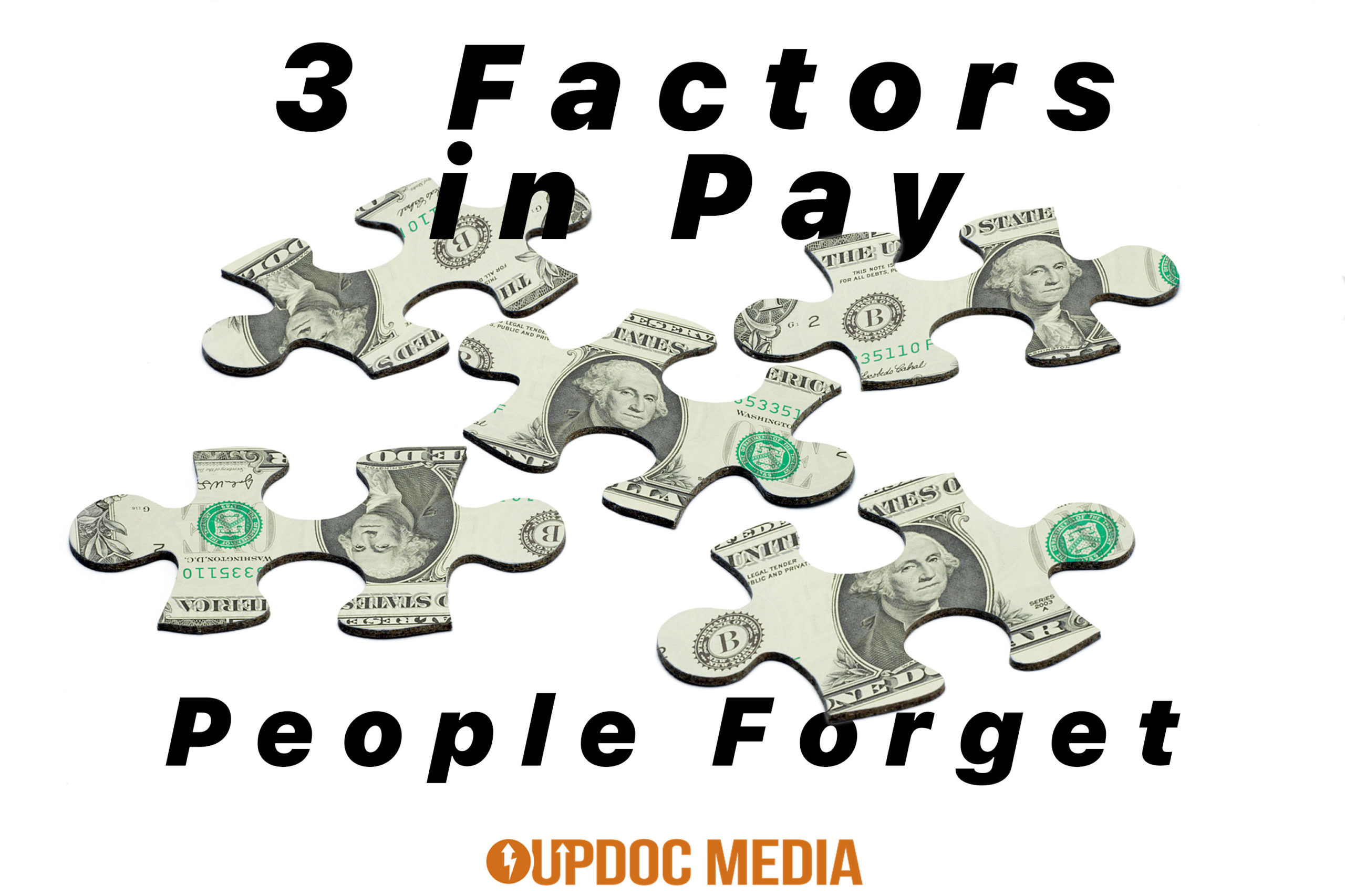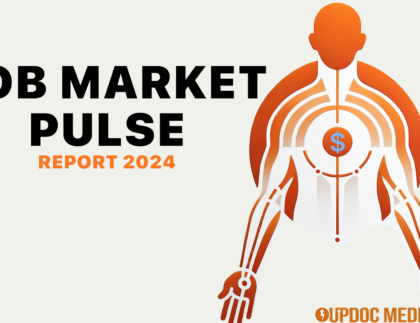
Here at UpDoc Media, our blog got its big start from Physical Therapy Job Market outlook content — addressing the popular but harder to answer questions of: What was average pay in which states, what were acceptable ranges, and then moved onto the fairly well known Job Market Pulse. As a result, one of our more public facing brand facets is being known for having a good idea of what pay can be, should be, could be negotiated for… in both the camp of the workforce as well as in the position of the practice manager in payer reimbursements.
After some recent conversations, social media threads, and private group posts — we felt it was important to cover some of the “less popular” aspects of wages & compensation. They are less popular because they don’t touch on specific dollar amounts you can immediately receive. However, these three factors very much influence the total dollar amounts and quality of life you will enjoy.
1. Cost of Time
There’s a financial term that investors and advisors love: Time Value of Money (TVM). Travel and Scheduling, getting paid for work time that may not be clinically oriented (such as documentation for home health) — the amount of time that it is costing you as a clinician to work for an employer needs to be taken into consideration. Here’s an example: Say you’re comparing opportunities “A” and “B” which are otherwise identical minus pay and distance of driving required.
- Job A
- Pays $80,000 / year at a Per Annum Equivalent.
- Job A will require a 20 minute drive from home to office/locations; a total of 40 minutes round trip on average per day.
- Job B
- Pays $100,000 / year at a Per Annum Equivalent
- Job B will require a 45 minute drive from home to office/locations; a total of 90 minutes round trip on average per day.
Before we do the math, let us just put it out there that if you’re on the road an hour a day, that’s going to be 5 hours a week in your car; and, that’s 20 hours of driving a month; and, assuming you’re working 5x 8 hour days for 50 weeks per year — you’re driving for 250 hours per year or 10.4 days a year… all in your car. Yikes.
So, for JOB A, what do we then have? 40 minutes round trip for 5x 8 hour days for 50 weeks comes up to almost 167 hours per year or 6.94 days per year in travel.
And, how about JOB B? 90 minutes round trip for 5x 8 hour days for 50 weeks comes up to almost 375 hours per year or 15.63 days per year in travel.
Now… imagine what that pushes out to the length of an employment tenure or across the length of entire career. Sure, it may only be 30 minutes more of driving per day. But, that also means that much more time lost to self, to family, to personal development, to PRN gigs, to home health pick-ups, to exploring niche or side-gig ventures, etc. etc. etc.
It get’s really scary when you put dollars to the time. Say we continue comparing something closer in proximity between Jobs A and B. Suppose the difference of only a one way 30 minute drive to a 45 minute drive, being that the difference is only 15 minutes between the two job opportunities. Well, at a round trip now we’re spending 30 minutes extra on Job B. At 5 days a week, 50 weeks per year… that’s 125 hours in transit. Say you would’ve been paid during part of that time if you went with Job A (the close one) — perhaps you’re willing to do some home health pickup evals. Even if you were only paid at a dollar per hour rate, say… just about $30/hour (which is dismally low for home health) — that comes up to nearly $4,000 to the year that could be making at a PRN, pick-up gig, or side-gig just by being physically available and not having your time consumed by travel.
AND… you should note that for this point, we’ve only used the cost of travel as an example for discussion.
You shouldn’t make your entire employment decision based on cost of time. Rather, this should be considered as one of the six primary dimensions of employee compensation. After all, going a further distance for a better workplace culture and career advancement avenues may very well be more than worth it — after all, the majority of healthcare consumers are willing to travel further for a better patient care experience. And, given all the data we’ve released on Talent Acquisition — I’d propose the same would be the case for us as a “provider care experience” by which employers can better engage their workforce, and, by which candidates can better select strong suited matches for their place of work.
2. Retirement Benefits
In recent times, retirement benefits haven’t been as popular as they once were. However, this doesn’t mean that you shouldn’t be paying attention — after all, this is one of the 6 primary dimensions of employee compensation and can turn into big dollars even only after a couple of years.
Most employers will offer some type of defined contributions plan — some, still offer some rather attractive defined benefits plans. In a short and gross oversimplification of the matter: Defined Contributions is what most retirement plans are seen to be where an employee puts away part of their salary, and much of the time, is matched by the employer to a certain degree. A defined benefits plan is what can be considered to be a modern day pension plan. While it has been noted that = these are going down the wayside, larger health systems, hospitals, government roles, and non-profits still carry these plans for eligible employees [see here for more detail].
For many, retirement portfolio is so far down the road — after all, we’re too busy paying off our student loans, right? While this may be true, it’s still prudent to think on retirement, particularly if those benefits are strongly matched and/or managed. The impressive fact is that if an employer is truly willing to match retirement contributions, there’s an incredible financial opportunity for employees. Let’s put together this fictitious-simple-numbers scenario:
- A clinician employee is making $80,000 / year at a per annum equivalent.
- They are putting away 5% off the top, and, the employer is matching the dollar up to 5%.
- This means that this employee would be saving $4,000 per year and gaining another $4,000 from the company.
- BEWARE: Many plans match at $0.25 to the dollar, have complex vesting schedules, or have tiers of contribution based on seniority.
- This, for one reason, is why we’re making this example simplified.
- AND, this is another reason to seek a professional financial planner when weighing complex compensation options.
- So, back to the scenario: At this point, the employee is now putting away $8,000/year and is essentially “gaining” at 5% raise or roughly $2.5/hour due to the matching plan.
- After 3 years at this company, they would’ve put away $24,000 — all the while the portfolio was growing with the market.
- Once vested and/or should the employee wish to exit the company and transfer this to something like a Roth IRA, after a (relatively mild) tax penalty should the tax conditions be incongruent, it’d be like a massive bonus or severance package. So… just be mindful on this matter 😉
- PS. If you’ve ever wondered why some of these benefits vest over a 3 – 5 year period; it’s because it typically takes a company that long to get their ROI per employee due to costs of replacement, productivity loss due to training, and other turnover factors. This vesting period can be a factor that helps at risk employees pump the brakes on leaving the company.
Now, before this point gets carried away, let us once again establish that we’re not financial professional here at UpDoc. However, we’ve seen a thing or two; and, we also help companies craft employee compensation packages — it’s an area we know well enough from an employee engagement angle. To this, we can share that there have been companies that are shifting back towards a benefits heavy compensation package just as much as there are companies shifting to a cash heavy package — it’s all a matter of cashflow and risk management. Benefits heavy packages tends to put risks on the employer while cash heavy packages tends to put risks on the workforce. As with all things, the right mixture and the right balance is important.
All this said, our biggest piece of advice is this: Candidates, you MUST understand the ENTIRE compensation package — it’s easy to focus on the money, but this money here isn’t exactly small and the devil is in the details. EMPLOYERS, your workforce and talent pool is becoming increasingly sensitive to personal finances due to the pressure of student debt — if there’s anything in this vein that you can help with, candidates and incumbent employees will be most appreciative indeed!
3. Career Advancement
Finally, this third factor in pay that can be so easily overshadowed is opportunities for career advancement. While most will take this to in the form of promotion and raises, career advancement should also encompass access to networking, conferences, committees, platforms, as well as opportunities to be seen and recognized by the profession and industry stakeholders at large.
I can’t tell you how rewarding it is for an employee to be recognized for excellence on stage while being handed a company award by the CEO, or, sent to a local new studio to give an expert’s opinion on back pain, spine health, or childhood development. This are things that money can’t buy and are moments that will earn your team’s loyalty for life — not to mention a very uplifting, morale boosting, flattering fifteen minutes of fame for said employees recognized in this fashion.
We should also note that according to our 2019 Talent Acquisition Report, career advancement and internal opportunities were considered among the most desired AND most lacking aspect in employee engagement for the Physical Therapy industry. So, with this as a backdrop, here are some areas you consider for any given organization’s internal development:
- Leadership tracks for clinical management.
- Leadership tracks for clinical specialties.
- Leadership tracks for business management.
- Emerging and new niche service line development tracks.
- Workforce tracks for non-clinical roles within a company.
- Partnerships with academia for company based clinical education.
- Partnerships with academia for company sponsored research.
- Liaison roles with local, state, and federal level advocacy and professional organizations.
- Employee engagement and talent acquisition roles in tandem with current operations in human resource / recruiting.
- Tracks that develop entry level employees into specialists in data science, population health, utilization review, compliance, outcomes, and accountability in clinical practice.
Oh, and one last thing: How does career advancement help with the “later dollars?” Most staff management positions receive a 5-10% raise off the cuff, dipping into 10-20% and even higher as you reach middle and senior management (depending on your organizational structure). And, that’s just in the way of direct dollars. There’s a whole bunch more to be said about personal branding and positioning for opportunity outside of the industry proper.
Pay and payment will always be a popular topic. Companies are trying to figure out ways to earn higher reimbursement and generate healthier profits while individual employees are trying to maximize their career paths in the fashion most meaningful to them. One thing we can say in firm confidence is that we’ve fully emerged into an economic age where companies that host the strongest cultures backed by measurable workforce engagement will find themselves in strong positions for a winning future.
If you’re looking for more resources on this and related topics, consider exploring our Ultimate Student (and, New Grad) Resource Collection, the results from our “Dear Employees… Dear Employers…” survey, 5 Ways To Make Your Manager’s Day, and How to Optimize Your Business for Millennials.









